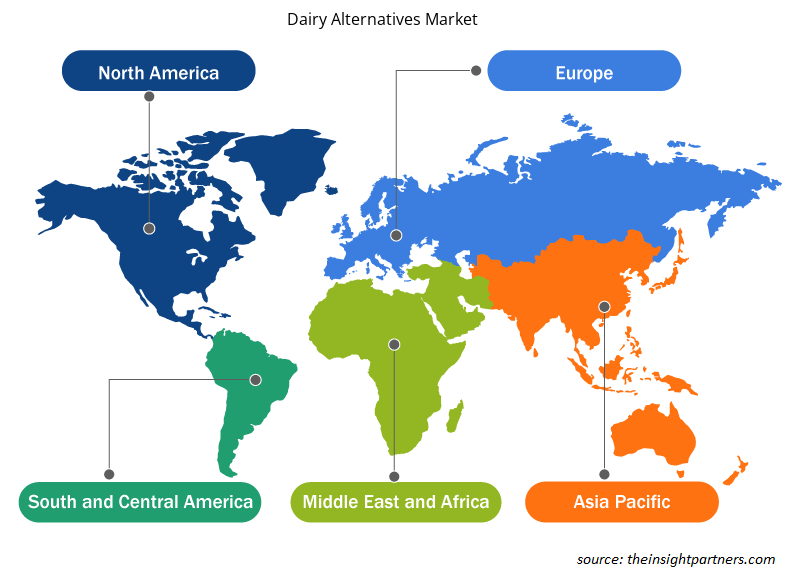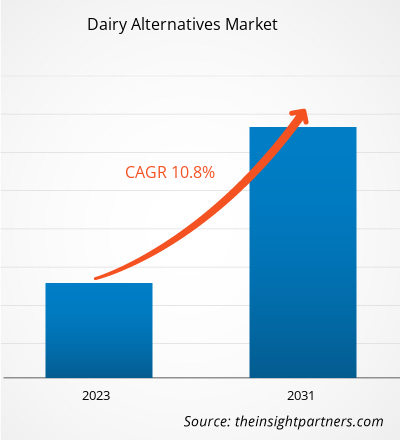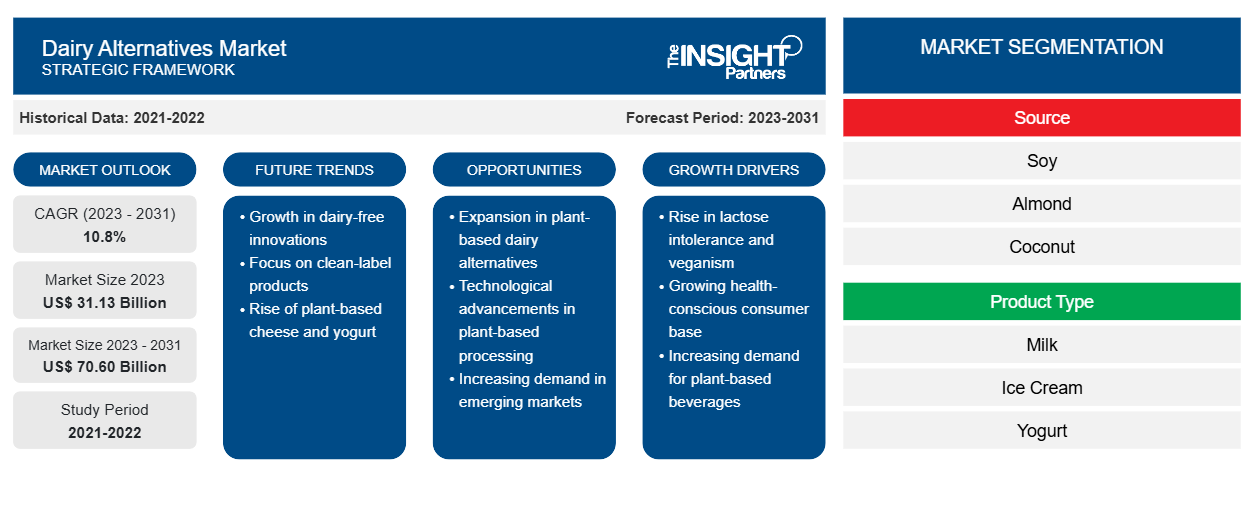乳制品替代品市场规模预计将从 2023 年的 311.3 亿美元增至 2031 年的 706.0 亿美元。预计 2023-2031 年期间该市场的复合年增长率将达到 10.8%。对功能性乳制品替代品的需求激增可能仍是市场的主要趋势。
乳制品替代品市场分析
过去几年,纯素食人口大幅增长。根据 Veganuary(一个鼓励全球个人在整个一月份坚持纯素食的非营利组织)的数据,2022 年有超过 620,000 人注册参加 Veganuary 活动,过去 3 年注册人数增长了 200%。由于对健康和可持续性的担忧日益增加,人们越来越多地转向纯素食。畜牧业是人类活动温室气体排放总量的重要贡献者之一。根据粮食及农业组织 (FAO) 的数据,全球畜牧业每年排放 7.1 亿吨二氧化碳,占人类活动温室气体排放总量的 14.5%。乳制品行业占畜牧业总排放量的 30%。
许多研究表明,转向纯素饮食可以显著降低二氧化碳排放量。瑞典查尔姆斯理工大学教授弗雷德里克·赫德努斯博士是《气候变化》杂志上发表的一篇关于肉类和奶制品消费的研究论文的合著者,他认为,减少肉类和奶制品的消费对于将农业气候污染降低到可接受的水平至关重要。
此外,联合国、善待动物组织和优质食品研究所等许多组织都认为素食主义有助于拯救地球免于气候危机。消费者对畜牧业对环境有害影响的认识正在提高。食用植物性乳制品有助于减少碳足迹、节约水和其他自然资源,并减少整体环境影响。因此,消费者正在迅速转向植物性乳制品和肉类产品。这一因素极大地推动了乳制品替代品市场的发展。
乳制品替代品市场概览
牛奶、酸奶、冰淇淋、奶酪和黄油等乳制品替代品由豆奶、豌豆奶和椰奶制成。豆奶比其他植物奶更实惠,并且它提供的蛋白质含量与全脂牛奶相似。由于人们对健康的关注度不断提高,对动物福利的认识不断提高,消费者非常倾向于选择植物性或纯素产品。植物性产品通常被认为是更健康的替代品。此外,奶牛养殖对整体环境产生负面影响,导致气候变化。这一因素也影响了乳制品替代品市场的增长。
定制此报告以满足您的需求
您可以免费定制任何报告,包括本报告的部分内容、国家级分析、Excel 数据包,以及为初创企业和大学提供优惠和折扣
-
获取此报告的关键市场趋势。这个免费样品将包括数据分析,从市场趋势到估计和预测。
乳制品替代品的市场驱动因素和机遇
乳糖不耐症发病率上升利好市场
根据美国国家糖尿病、消化和肾脏疾病研究所 (NIDDK) 的数据,全球平均有 68% 的人口患有乳糖不耐症。根据美国国立卫生研究院 (NIH) 的数据,乳糖不耐症在东亚成年人口中相当常见,影响到这些社区 75-95% 的人口。此外,先天性乳糖缺乏症在亚太地区和非洲地区普遍存在。因此,中国、日本、韩国和台湾等国家是乳制品替代品的潜在市场。
植物性乳制品的质地、乳脂度和稠度与传统乳制品相似。它们富含蛋白质和钙等营养成分,可满足消费者的日常营养需求。因此,消费者中乳糖不耐症和牛奶过敏的日益普遍正在推动乳制品替代品市场的发展。
新产品发布数量不断增加,带来巨大增长机会
乳制品替代品制造商正在对产品创新进行大量投资,以吸引大量消费者。产品创新战略为市场参与者提供了竞争优势,提高了他们的盈利能力。乳制品替代品制造商提供经过认证的有机、非转基因、无麸质、清洁标签和无过敏原产品,以满足新兴客户的需求。此外,随着消费者的健康意识增强,他们更喜欢低热量和低脂肪的产品。因此,植物性乳制品制造商提供不加糖和低糖的产品。例如,2021 年 2 月,Hasla Foods 推出了 24 盎司家庭装零糖燕麦奶酸奶。该产品每份仅含 90 卡路里,不添加糖。2021 年 6 月,该公司扩大了零售足迹,在美国 160 家 National Grocers by Vitamin Cottage 商店销售其产品。
此外,制造商正在尝试不同的植物奶来源,如大麦、豌豆、大麻、奇亚籽、香蕉和腰果。例如,植物奶的主要制造商之一 Take Two Foods 提供营养丰富的大麦奶,这种奶含有蛋白质、纤维、钙和不饱和脂肪等完整营养成分。预计此类策略将在预测期内为乳制品替代品市场提供有利可图的机会。
乳制品替代品市场报告细分分析
有助于得出乳制品替代品市场分析的关键部分是来源、产品类型和分销渠道。
- 根据来源,乳制品替代品市场分为大豆、杏仁、椰子、燕麦等。大豆部分在 2023 年占据了最大的市场份额。大豆预计将在美国老年人和女性消费者中越来越受欢迎,因为它含有异黄酮,据称可以降低患心脏病和乳腺癌的风险。大豆还含有植物雌激素,这是一种在女性体内作用类似于雌激素的激素。食用大豆乳制品替代品在女性中很受欢迎,是一种提高雌激素水平的替代疗法。与其他乳制品替代品相比,大豆营养丰富,蛋白质含量高;因此,大豆因其益处而受到欢迎,最终在预测期内推动了该细分市场的市场发展。
在分销渠道方面,市场细分为超市和大卖场、便利店、在线零售等。超市和大卖场在 2023 年占据了市场主导地位。超市和大卖场是大型零售机构,提供各种杂货、食品、饮料和其他家居用品。这些商店以合理的价格提供各种品牌的产品,让购物者能够快速找到合适的产品。此外,这些商店提供诱人的折扣、多种付款方式和愉快的客户体验。超市和大卖场专注于最大化产品销售以提高利润率。植物性乳制品制造商通常更喜欢通过超市和大卖场销售产品,因为这些商店的客流量很大。城市化进程加快、工薪阶层人口增加以及有竞争力的定价提高了超市和大卖场在发达和发展中地区的受欢迎程度。
乳制品替代品市场份额(按地区)分析
乳制品替代品市场报告的地理范围主要分为五个地区:北美、亚太、欧洲、中东和非洲、南美/南美和中美。
2023 年,亚太地区乳制品替代品市场占有最大的市场份额。近年来,由于乳糖不耐症患者数量不断增加,以及人们对牛奶中常见的抗生素和生长激素的健康担忧,牛奶替代品的消费量稳步增长。乐天在 2021 年进行的研究表明,87% 的中国消费者尝试过植物奶,50% 的消费者尝试过其他乳制品替代品,42% 的消费者尝试过植物肉,32% 的消费者尝试过纯素鸡蛋替代品。此外,同一项研究还发现,3% 的受访者只食用植物性食物。因此,由于亚太地区乳糖不耐症的患病率不断上升,对植物性乳制品的需求不断增加,乳制品替代品市场正在增长。
乳制品替代品市场区域洞察
Insight Partners 的分析师已详尽解释了预测期内影响乳制品替代品市场的区域趋势和因素。本节还讨论了北美、欧洲、亚太地区、中东和非洲以及南美和中美洲的乳制品替代品市场细分和地理位置。

- 获取乳制品替代品市场的区域特定数据
乳制品替代品市场报告范围
| 报告属性 | 细节 |
|---|---|
| 2023 年的市场规模 | 311.3亿美元 |
| 2031 年市场规模 | 706亿美元 |
| 全球复合年增长率(2023 - 2031) | 10.8% |
| 史料 | 2021-2022 |
| 预测期 | 2023-2031 |
| 涵盖的领域 |
按来源
|
| 覆盖地区和国家 |
北美
|
| 市场领导者和主要公司简介 |
|
乳制品替代品市场参与者密度:了解其对业务动态的影响
乳制品替代品市场正在快速增长,这得益于终端用户需求的不断增长,而这些需求又源于消费者偏好的不断变化、技术进步以及对产品优势的认识不断提高等因素。随着需求的增加,企业正在扩大其产品范围,进行创新以满足消费者的需求,并利用新兴趋势,从而进一步推动市场增长。
市场参与者密度是指在特定市场或行业内运营的企业或公司的分布情况。它表明在给定市场空间中,相对于其规模或总市场价值,有多少竞争对手(市场参与者)存在。
在乳制品替代品市场运营的主要公司有:
- 太阳光电
- 蓝钻石种植者
- 雀巢公司
- 达能公司
- 燕麦公司
- Califia Farms, LLC
免责声明:上面列出的公司没有按照任何特定顺序排列。

- 获取乳制品替代品市场顶级关键参与者概述
乳制品替代品市场新闻和最新发展
通过收集主要和次要研究后的定性和定量数据来评估乳制品替代品市场,其中包括重要的公司出版物、协会数据和数据库。以下是言语和语言障碍市场的发展列表:
- 植物奶品牌milkadamia 进军冷藏领域,并首次推出有机手工澳洲坚果奶和混合奶系列,证明“少即是多”。该系列摒弃了许多非乳制饮料中常见的填充剂和胶质,满足了人们对更多类似自制食品日益增长的需求。(来源:乳制品替代品——Milkadamia,新闻稿/公司网站/通讯,2024 年)
- Califia Farms 推出了 Califia Farms Complete,这是一款奶油植物奶,含有九种必需营养素、八克蛋白质、所有九种必需氨基酸,糖分仅为牛奶的一半。(来源:Dairy Alternatives Califia Farms LLC,新闻稿/公司网站/时事通讯,2024 年)
乳制品替代品市场报告覆盖范围和交付成果
“乳制品替代品市场规模和预测(2023-2031)”报告对市场进行了详细分析,涵盖以下领域:
- 范围内涵盖的所有主要细分市场的全球、区域和国家层面的市场规模和预测
- 市场动态,如驱动因素、限制因素和关键机遇
- 未来主要趋势
- 详细的 PEST/波特五力分析和 SWOT 分析
- 全球和区域市场分析涵盖关键市场趋势、主要参与者、法规和最新市场发展
- 行业格局和竞争分析,涵盖市场集中度、热点图分析、知名参与者和最新发展
- 详细的公司简介
- 历史分析(2 年)、基准年、预测(7 年)及复合年增长率
- PEST和SWOT分析
- 市场规模、价值/数量 - 全球、区域、国家
- 行业和竞争格局
- Excel 数据集
近期报告
客户评价
购买理由
- 明智的决策
- 了解市场动态
- 竞争分析
- 客户洞察
- 市场预测
- 风险规避
- 战略规划
- 投资论证
- 识别新兴市场
- 优化营销策略
- 提升运营效率
- 顺应监管趋势























 获取免费样品 - 乳制品替代品市场
获取免费样品 - 乳制品替代品市场